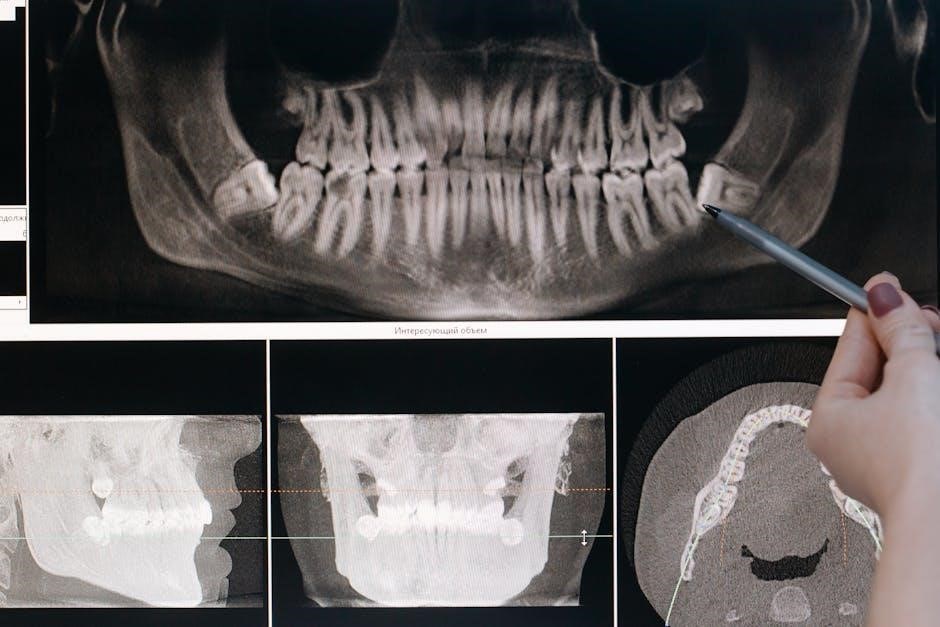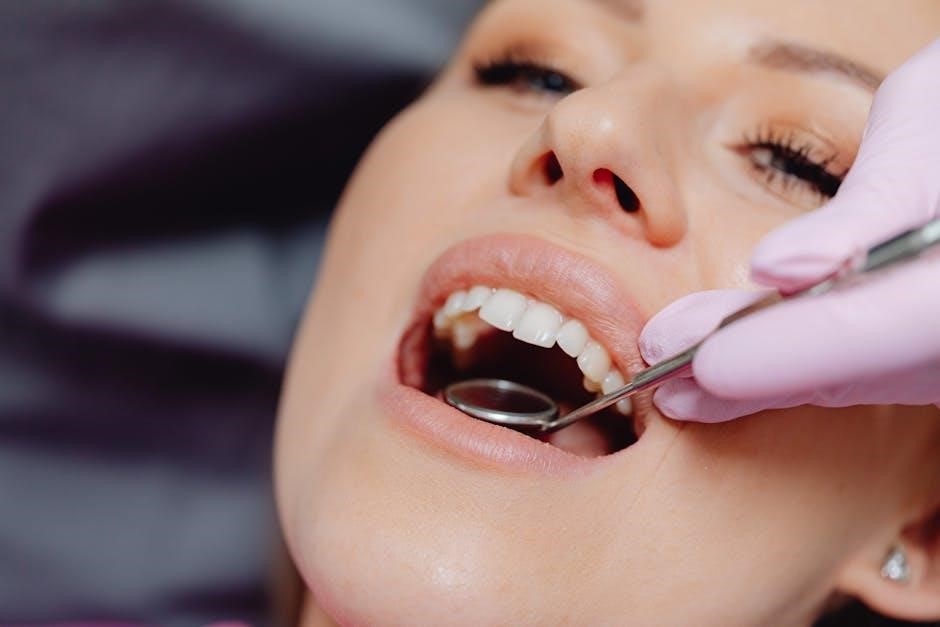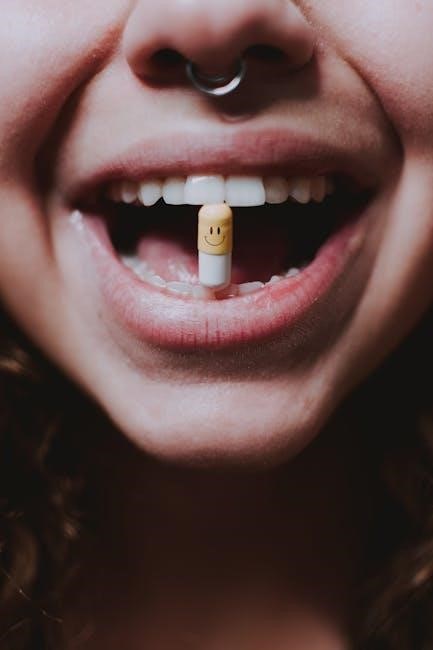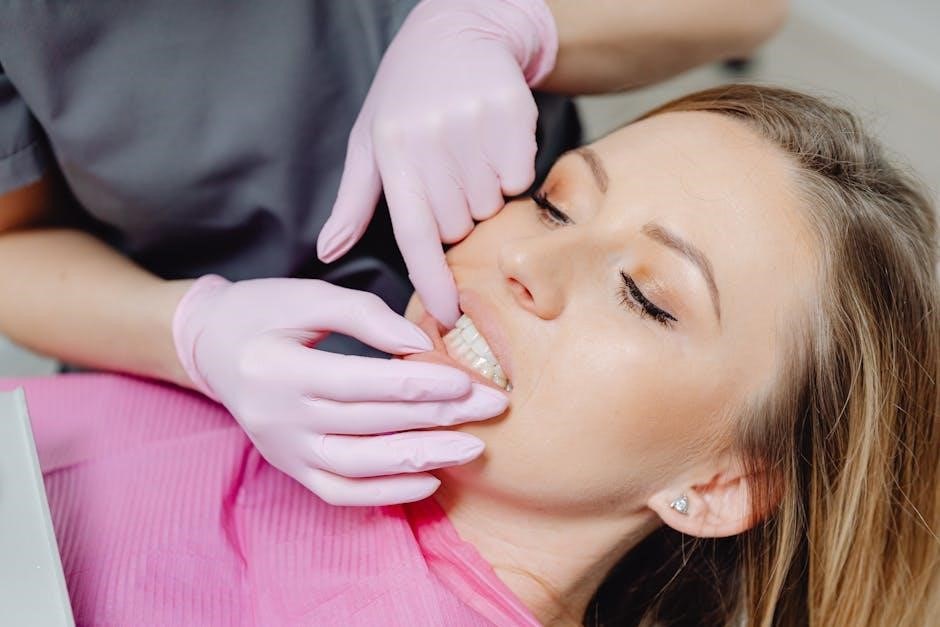Oral B Whitening Strips are a popular, easy-to-use solution for at-home teeth whitening. Designed with enamel-safe ingredients, they offer visible results in just a few days.
What Are Oral B Whitening Strips?
Oral B Whitening Strips are thin, flexible strips coated with a peroxide-based gel designed to adhere to teeth and lift stains. They are part of a 14-day at-home teeth whitening treatment. Each strip is applied to the front of the teeth, aligning with the gum line, and worn for 1 hour daily. The gel contains hydrogen peroxide, which penetrates enamel to remove both surface and subsurface stains. The strips are easy to use and provide visible results within a few days. They are a convenient and effective way to achieve a brighter smile without professional dental supervision. The product is designed for individuals looking for an affordable and safe teeth whitening solution at home.
Benefits of Using Oral B Whitening Strips
Oral B Whitening Strips offer several benefits, including convenience, affordability, and noticeable results. They are designed for at-home use, making them a practical alternative to professional teeth whitening treatments. The strips are easy to apply and require minimal time commitment, with just one hour of wear per day. Users typically notice visible improvements in tooth color within a few days, with full results achievable in 14 days. The enamel-safe formula ensures safety while effectively lifting stains. Additionally, the strips are a cost-effective solution compared to dental office procedures. They provide a comfortable and hassle-free way to achieve a brighter, whiter smile without sacrificing time or money. Regular use can also help maintain results for a longer period.
How Whitening Strips Work
Oral B Whitening Strips function by applying a thin layer of peroxide-based gel directly onto the teeth. This gel penetrates the tooth enamel to break down and neutralize stains, both on the surface and beneath. The strips are designed to adhere firmly to the teeth, ensuring even distribution of the whitening agent. When worn for the recommended time, typically 60 minutes daily, the active ingredients work to lift discoloration. The process is gradual, with noticeable results often appearing after several applications. The strips’ adhesive backing ensures they stay in place, allowing the gel to work effectively without interruption. This method is both efficient and gentle, making it a popular choice for achieving a whiter smile at home. Regular use as directed maximizes the whitening effect.

Key Considerations Before Using Whitening Strips
Assess tooth discoloration type, sensitivity, and gum health before use. Consult a dentist for severe stains or underlying issues to ensure safe and effective results.
Understanding Tooth Discoloration
Tooth discoloration can be intrinsic (inside the tooth) or extrinsic (surface stains). Intrinsic stains result from trauma, medication, or aging, while extrinsic stains come from food, smoking, or poor hygiene.
Whitening strips are most effective on extrinsic stains, as they target surface discoloration. However, intrinsic stains may require professional treatments like veneers or bleaching.
Understanding the cause of discoloration helps determine the best treatment approach. Always consult a dentist for severe or unclear cases to ensure proper care and avoid unnecessary procedures.
Who Should Use Whitening Strips?
Whitening strips are suitable for individuals with mild to moderate tooth discoloration caused by food, coffee, or smoking. They are ideal for those seeking a convenient, at-home solution.
People with healthy gums and teeth can benefit most, as strips may irritate sensitive gums or worn enamel. Avoid using strips if you have dental work like fillings or crowns that match your natural tooth color.
Pregnant or breastfeeding women should consult their dentist before use. Always follow the manufacturer’s instructions to ensure safety and effectiveness.
Precautions and Contraindications
Before using Oral B Whitening Strips, ensure you have healthy teeth and gums. Avoid using them if you have gum disease, tooth decay, or worn enamel, as this may cause irritation.
Pregnant or breastfeeding women should consult their dentist before starting treatment. Additionally, individuals with dental work such as fillings, crowns, or veneers should avoid using whitening strips, as they may not whiten artificial surfaces.
If you experience sensitivity or discomfort, discontinue use and consult a dentist. Always adhere to the recommended usage instructions to minimize potential side effects and ensure safe, effective results.

Step-by-Step Instructions for Using Oral B Whitening Strips
Peel the strips from the backing and apply the gel side to your teeth. Align with the gum line, press gently, and fold excess behind teeth. Wear for 1 hour, once daily, for best results.
Preparation Before Application
Before applying Oral B Whitening Strips, ensure your teeth are clean and dry. Brushing your teeth gently with water is recommended to remove any plaque or debris. Avoid using toothpaste or mouthwash, as they might interfere with the strip’s adhesion. Rinse your mouth thoroughly and pat your teeth dry with a clean cloth or tissue. This preparation helps the strips adhere properly and maximizes their effectiveness. Properly preparing your teeth ensures optimal contact between the whitening gel and your enamel, leading to better results and minimizing potential side effects. This step is crucial for achieving the desired whitening outcome.
Peeling and Applying the Strips
To apply Oral B Whitening Strips, start by peeling the strips from their plastic backing. Identify the gel side, which should face your teeth during application. Using a mirror for accuracy, align the strip with your gum line and gently press it onto your teeth. Ensure the strip is smooth and evenly applied, folding any excess strip behind your teeth to secure it in place. For upper and lower teeth, repeat the process with a second strip. Proper alignment and contact are essential for even whitening. Avoid stretching or overlapping the strips, as this may cause uneven results or discomfort. Once applied, leave the strips on for the recommended 1 hour or as per the product instructions.
Wearing Time and Removal
Once applied, wear the Oral B Whitening Strips for the recommended 1 hour. This duration ensures optimal whitening without overexposure to the active ingredients. After the wearing time, carefully peel the strips from the edge, starting at the back of your teeth and working your way forward. Avoid pulling or jerking the strips, as this could irritate your gums. After removal, rinse your mouth with water to remove any residual gel. Do not brush your teeth immediately after removal to allow your enamel to rest. For best results, avoid eating or drinking for at least 30 minutes post-removal. Proper removal and aftercare help maintain comfort and effectiveness throughout your whitening treatment.
Post-Application Care
After removing the Oral B Whitening Strips, rinse your mouth with water to eliminate any remaining gel. Avoid brushing your teeth for at least 30 minutes to prevent enamel irritation. For the next 30 minutes, refrain from consuming food, beverages, or tobacco products to allow the whitening agents to fully absorb. This helps maintain the effectiveness of the treatment and prevents staining. Continue your regular oral hygiene routine afterward, including brushing with fluoride toothpaste to strengthen your enamel. If you experience sensitivity, consider using a desensitizing toothpaste. Proper post-application care ensures long-lasting results and protects your teeth and gums from potential discomfort. Consistency in following these steps enhances the overall success of your teeth whitening experience.

Optimizing Results with Whitening Strips
For best results, use strips consistently as directed, avoid staining foods/drinks, and consider combining with fluoride toothpaste to enhance and maintain your whitening outcomes effectively.
Frequency of Use
For optimal results, Oral B Whitening Strips should be used once daily for 1 hour over a 14-day period. Consistency is key to achieving noticeable whitening. The strips contain a mild hydrogen peroxide formula, designed to gently lift stains without damaging enamel. Overuse can lead to tooth sensitivity or gum irritation, so adhering to the recommended frequency is essential. After completing the full treatment, touch-ups can be done as needed, typically every 6 months, to maintain results. Always follow the instructions provided to ensure safety and effectiveness. Proper use enhances outcomes and minimizes potential side effects, making it a reliable at-home whitening solution.
Dietary Recommendations During Treatment
During the use of Oral B Whitening Strips, it’s advisable to avoid consuming staining foods and beverages, such as coffee, tea, red wine, and berries. These can hinder the whitening process and stain the strips. Additionally, acidic foods like citrus fruits or sodas should be limited to prevent enamel weakening. Opt for water and non-acidic snacks to maintain a clean surface for the strips to work effectively. Avoid smoking, as it can counteract the whitening results. A balanced diet rich in calcium and vitamins helps support overall oral health. By making these dietary adjustments, you can enhance the effectiveness of the whitening treatment and achieve a brighter, longer-lasting smile. Proper care during treatment ensures optimal results and protects your teeth.
Combining with Other Oral Care Products
Oral B Whitening Strips can be complemented with other oral care products to enhance results. For instance, using a whitening toothpaste or mouthwash alongside the strips may improve stain removal and maintain brightness. However, avoid using abrasive products or those containing bleaching agents simultaneously, as this could over-sensitize teeth or gums. It’s important to follow the product instructions and ensure compatibility. Many users report success when pairing the strips with fluoride toothpaste for cavity protection. Always prioritize enamel safety and avoid over-whitening. Consulting a dentist before combining treatments is recommended to ensure optimal oral health and achieve the best possible outcomes. Proper coordination of products can lead to a more radiant and healthy smile.

Safety and Side Effects
Oral B Whitening Strips are generally safe but may cause temporary tooth sensitivity or gum irritation. Follow instructions carefully to minimize side effects.
Common Side Effects
The most common side effects of Oral B Whitening Strips include mild tooth sensitivity and gum irritation. These reactions are usually temporary and subside once treatment is completed. In some cases, users may experience a slight tingling sensation or discomfort, which is generally manageable. It’s important to follow the instructions precisely to minimize these effects. If sensitivity persists or worsens, consider alternating with sensitive-friendly products or consulting a dentist. Proper application and adherence to recommended usage times can help reduce the risk of adverse reactions, ensuring a safe and effective teeth-whitening experience. Always prioritize your oral health and seek professional advice if issues persist.
Managing Sensitivity
To manage sensitivity while using Oral B Whitening Strips, start by using a sensitive-friendly toothpaste 1-2 weeks before treatment. This helps desensitize your teeth. During application, avoid overlapping strips on gums and rinse thoroughly after removal. If sensitivity occurs, consider alternating days or shortening wear time. Avoid consuming hot or cold foods/drinks for a few hours post-treatment. If discomfort persists, discontinue use or consult a dentist. Sensitivity is usually temporary but should be monitored to ensure oral health. Always follow instructions carefully to minimize discomfort and achieve desired results safely.
Emergency Measures for Overexposure

If overexposure occurs, rinse your mouth thoroughly with water to neutralize the whitening agent. Apply a fluoride mouthwash or toothpaste to help soothe and protect your teeth and gums. Discontinue use until consulting a dentist. For severe irritation or burns, apply a desensitizing toothpaste and avoid hot or cold foods/drinks. If symptoms persist, seek professional dental advice immediately. Always follow the recommended usage to prevent overexposure and ensure safe, effective results. Proper care and adherence to instructions are key to avoiding such issues while using Oral B Whitening Strips.

Comparing Oral B Whitening Strips to Other Brands
Oral B Whitening Strips stand out for their effectiveness and ease of use, offering comparable results to professional treatments at a fraction of the cost.
Oral B vs. Crest Whitestrips
Oral B Whitening Strips and Crest Whitestrips are both leading at-home teeth whitening solutions, offering similar effectiveness but differing in application and ingredients. Oral B strips use hydrogen peroxide, while Crest Whitestrips utilize a similar active ingredient for stain removal. Crest Whitestrips are known for their convenience and quick results, often combined with an LED accelerator light for enhanced outcomes. Oral B strips, however, are praised for their ease of use and gentle formula, making them suitable for sensitive teeth. Both brands require peeling and applying the strips to the front teeth, aligning with the gum line, and wearing them for approximately 30 minutes to an hour. Users often choose based on personal preference, with some favoring Crest for faster results and others preferring Oral B for its straightforward instructions and comfort during application. Both are enamel-safe and deliver noticeable whitening results, making them top choices for at-home teeth whitening.
Oral B vs. Spotlight Oral Care
Oral B Whitening Strips and Spotlight Oral Care offer distinct approaches to at-home teeth whitening. Oral B strips are known for their ease of use and quick results, with visible whitening in just a few days. Spotlight Oral Care, on the other hand, offers a combination of whitening strips and toothpaste, providing a comprehensive whitening system. Both products are enamel-safe and utilize hydrogen peroxide for effective stain removal. Spotlight Oral Care is often praised for its gentle formula, catering to those with sensitive teeth, while Oral B strips are preferred for their straightforward application and consistent results. The choice between the two may depend on individual preferences, with Spotlight offering a more holistic approach and Oral B excelling in simplicity and effectiveness. Both brands deliver professional-grade whitening at home, making them top contenders in the market.
Oral B vs. Lumineux Teeth Whitening Strips
Oral B Whitening Strips and Lumineux Teeth Whitening Strips are both popular at-home whitening solutions but cater to different needs. Oral B strips are known for their quick results, with visible improvements in just a few days, making them ideal for those seeking fast transformations. They use hydrogen peroxide, a common whitening agent, and are designed for easy application. Lumineux, on the other hand, focuses on sensitivity, offering non-toxic, coconut-flavored strips that are gentle on enamel. Lumineux is certified non-toxic, appealing to users who prioritize safety and comfort. While Oral B excels in speed and effectiveness, Lumineux provides a more natural, gentle whitening experience. Both brands deliver professional-grade results but cater to different preferences and sensitivities.

Maintaining Your Smile After Treatment
To maintain your smile after using Oral B Whitening Strips, avoid staining foods, brush regularly with fluoride toothpaste, and consider touch-ups every few months. Proper care ensures long-lasting results.
Post-Whitening Care
After completing your Oral B Whitening Strips treatment, maintain your results by avoiding staining foods and beverages, such as coffee, tea, and red wine. Brush your teeth twice daily with fluoride toothpaste to protect enamel and prevent discoloration. Avoid smoking or using tobacco products, as they can stain teeth. For long-lasting results, consider touch-up treatments every few months. Additionally, incorporate good oral hygiene practices, such as regular flossing and dental check-ups, to ensure your smile remains bright and healthy. By following these care tips, you can preserve the whiteness and overall health of your teeth for an extended period. Proper post-whitening care is essential to uphold the effectiveness of the treatment.
Touch-Up Treatments
Touch-up treatments with Oral B Whitening Strips are an excellent way to maintain your bright smile over time. After completing the initial treatment, periodic touch-ups can help preserve the results by addressing any new stains or discoloration. Use the strips every few months, as needed, to keep your teeth looking their best. These treatments are quick and convenient, fitting seamlessly into your oral care routine. By incorporating touch-ups, you can ensure your smile remains vibrant and youthful. Regular touch-ups are especially beneficial for those who consume staining foods or beverages regularly. Proper storage of the strips in a cool, dry place will help maintain their effectiveness for future use. Consistency is key to long-lasting results.
Lifestyle Changes for Long-Lasting Results
To maintain the results of Oral B Whitening Strips, adopting a few simple lifestyle changes is essential. Limiting the consumption of staining beverages like coffee, tea, and red wine can help prevent discoloration. Smoking and tobacco use should be avoided, as they significantly contribute to tooth stains. Additionally, incorporating a balanced diet rich in fruits and vegetables can support overall oral health. Regular brushing with fluoride toothpaste and flossing are crucial for maintaining a clean and healthy smile. Avoiding sugary snacks can also prevent plaque buildup, which may dull your teeth over time. By combining these habits with consistent use of whitening strips, you can enjoy a radiant smile for years to come. These small adjustments make a big difference in preserving your whitening results.

Troubleshooting Common Issues
Common issues with Oral B Whitening Strips include strips not adhering properly, uneven whitening, and mild discomfort. These can often be resolved with proper application and care.
Strips Not Adhering Properly
If Oral B Whitening Strips fail to adhere, ensure teeth are dry before application. Saliva or moisture can prevent proper sticking. Align strips with the gum line and press gently for firm contact. Folding excess strip behind teeth secures placement. Avoid touching the gel side with fingers to maintain adhesive properties. If strips still don’t stick, reposition without wetting the gel. Proper technique is key for optimal results.
Improper adhesion can reduce effectiveness or cause uneven whitening. Follow instructions carefully to ensure strips stay in place during the recommended wearing time. If issues persist, check for damaged strips or improper storage.
Uneven Whitening
Uneven whitening with Oral B Whitening Strips can occur due to improper application or inconsistent use. Ensure strips cover all visible front teeth and align correctly with the gum line. Avoid overlapping strips, as this may cause uneven results. For best outcomes, use strips as directed—once daily for the recommended duration. If unevenness persists, consider touch-up treatments or consult a dentist for professional advice. Proper technique and adherence to instructions are crucial for achieving uniform whitening results.
Regular use and correct application maximize effectiveness, helping you achieve a brighter, more even smile.
Discomfort or Irritation
Discomfort or irritation while using Oral B Whitening Strips is typically mild and temporary. This may include tooth sensitivity or gum irritation, often caused by the hydrogen peroxide in the strips. To minimize discomfort, ensure proper application and avoid overlapping strips. If sensitivity occurs, consider using strips every other day or switching to a sensitive-teeth formula. Avoid using strips longer than recommended, as this can exacerbate irritation. If discomfort persists, discontinue use and consult a dentist. For sensitive teeth, brush with a desensitizing toothpaste before applying strips. Avoid consuming hot or cold foods and drinks immediately after use to reduce sensitivity. Always follow the instructions carefully to minimize potential discomfort and ensure a safe, effective whitening experience.
Oral B Whitening Strips offer a safe and effective way to achieve a brighter smile from home. Follow instructions carefully for the best results and long-term benefits.

Final Tips for Success
For optimal results with Oral B Whitening Strips, consistency is key. Ensure teeth are dry before application to enhance adhesion. Align strips carefully with the gum line and press gently for proper contact. Avoid consuming stain-causing foods and beverages during treatment. Maintain good oral hygiene practices, such as brushing and flossing, to support whitening efforts. If sensitivity occurs, consider using a desensitizing toothpaste. Store strips in a cool, dry place to maintain effectiveness. For touch-ups, use strips sparingly to avoid overexposure. Monitor progress and adjust usage as needed. Always handle strips with clean, dry hands to prevent contamination. When removing, peel slowly to avoid irritation. Combining with other oral care products can enhance results, but follow instructions carefully for safety and effectiveness.
Long-Term Benefits of Whitening Strips
Oral B Whitening Strips offer long-lasting results when used consistently and as directed. By removing deep stains and surface discoloration, they help maintain a brighter smile over time. With proper care, results can last for several months, boosting confidence and enhancing overall appearance. Regular touch-ups can further extend the benefits, ensuring your teeth remain vibrant. Proper oral hygiene practices, such as brushing and flossing, complement the strips’ effectiveness. Avoiding stain-causing foods and beverages also helps preserve the results. Over time, the strips’ enamel-safe formula gently maintains whiteness without damaging tooth enamel. For sustained success, follow the recommended usage and post-care instructions to enjoy a radiant smile for years to come. Consistency and patience are key to achieving and maintaining long-term benefits.
When to Consult a Dentist
If you experience persistent sensitivity, uneven whitening, or discomfort after using Oral B Whitening Strips, it’s important to consult a dentist. They can assess your oral health and address underlying issues. Severe tooth discoloration or stains that don’t improve may require professional treatment. Additionally, if you have dental work like fillings or crowns, a dentist can ensure the strips won’t interfere with these restorations. Consulting a dentist before starting any whitening treatment is also recommended, especially for sensitive teeth or gums. They can guide you on the best approach for your specific needs and ensure safe, effective results. Regular dental check-ups are essential to maintain oral health and address any concerns early. Always prioritize professional advice for tailored care.